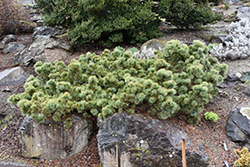It's all about ...
plants

Compact Blue Japanese Stone Pine
Pinus pumila 'Glauca'
Height: 18 inches
Spread: 5 feet
Sunlight:
![]()
Hardiness Zone: 3b
Other Names: Dwarf Siberian Pine
Description:
A choice and yet virtually unknown variety of dwarf pine that hugs the ground as it trails over rocks, yet maintaining a distinctively upright branching character; needles have a prominent silver streak that gives the plant an overall bluish hue
Ornamental Features
Compact Blue Japanese Stone Pine is a dwarf conifer which is primarily valued in the garden for its broadly spreading habit of growth. It features showy red catkins along the branches in late spring. It has attractive forest green foliage with silvery blue stripes which emerges light green in spring. The needles are highly ornamental and remain forest green throughout the winter.
Landscape Attributes
Compact Blue Japanese Stone Pine is a multi-stemmed evergreen shrub with a ground-hugging habit of growth. Its average texture blends into the landscape, but can be balanced by one or two finer or coarser trees or shrubs for an effective composition.
This is a relatively low maintenance shrub. When pruning is necessary, it is recommended to only trim back the new growth of the current season, other than to remove any dieback. It has no significant negative characteristics.
Compact Blue Japanese Stone Pine is recommended for the following landscape applications;
- Mass Planting
- Rock/Alpine Gardens
- General Garden Use
Planting & Growing
Compact Blue Japanese Stone Pine will grow to be about 18 inches tall at maturity, with a spread of 5 feet. It tends to fill out right to the ground and therefore doesn't necessarily require facer plants in front. It grows at a slow rate, and under ideal conditions can be expected to live for 50 years or more.
This shrub should only be grown in full sunlight. It prefers dry to average moisture levels with very well-drained soil, and will often die in standing water. It is not particular as to soil type or pH. It is somewhat tolerant of urban pollution. This is a selected variety of a species not originally from North America.
This plant is not reliably hardy in our region, and certain restrictions may apply; contact the store for more information.
